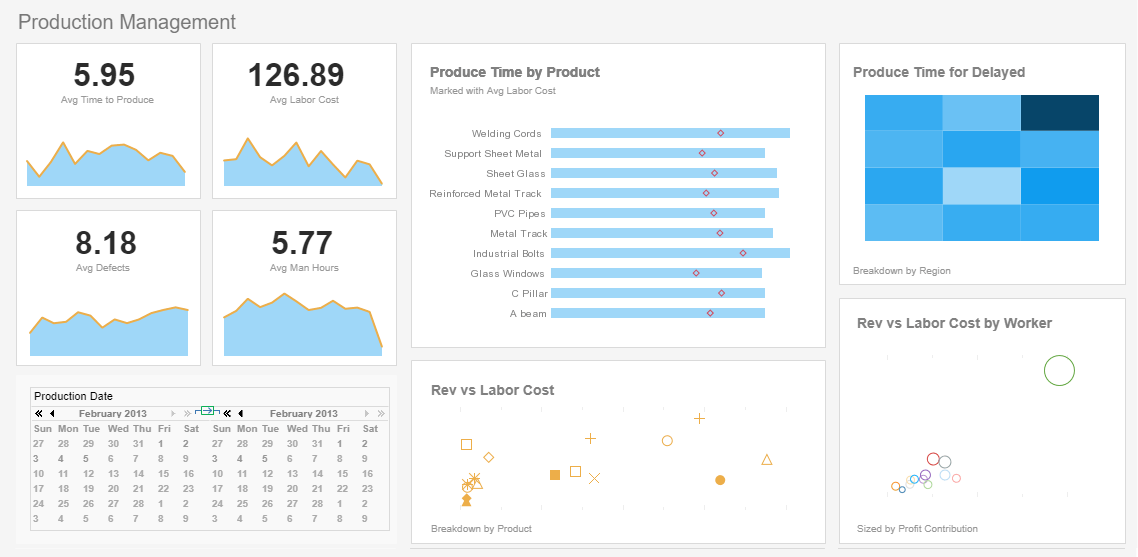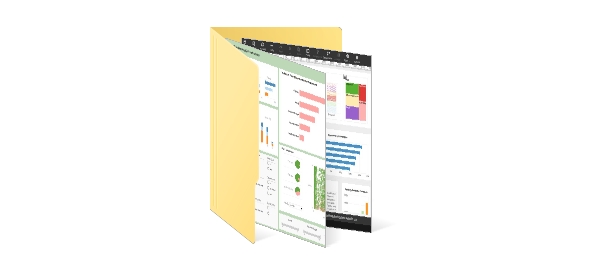Evaluate InetSoft's Mature and Feature-Rich Web-based Reporting Engine
InetSoft provides a high-performance Web-based reporting engine that enables sophisticated and flexible production and ad hoc reporting.
A characteristic of enterprise reporting is that the data sources tend to be diverse in nature. A reporting application often needs to retrieve data from multiple data sources, each with a different protocol.
Instead of forcing a relational view on all data sources, the Style Report reporting engine allows report developers to connect to any data source through a Java API, and the most common data sources using the visual query builder.
Key Capabilities Include:
- Deliver professional, high fidelity presentation
- Transform and manipulate raw data
- Embed business logic with scripting
- Enhance manageability and agility
You can deliver on-demand reports on the Web. In-report exploration capabilities empower business users with the ability to reshape information in real time.
Key Benefits Include the Ability to:
- Gather up-to-the-minute information
- Reshape reports in real time
- Minimize performance bottlenecks
- Satisfy business users and data specialists
InetSoft's report scheduling, bursting, and archiving capabilities allow for flexible batch report generation. Report bursting separates report pages into security controlled sections.
About InetSoft
Since 1996 InetSoft has been delivering easy, agile, and robust business intelligence software that makes it possible for organizations and solution providers of all sizes to deploy or embed full-featured business intelligence solutions. Application highlights include visually-compelling and interactive dashboards that ensure greater end-user adoption plus pixel-perfect report generation, scheduling, and bursting.
InetSoft's patent pending Data Block™ technology enables productive reuse of queries and a unique capability for end-user defined data mashup. This capability combined with efficient information access enabled by InetSoft's visual analysis technologies allows maximum self-service that benefits the average business user, the IT administrator, and the developer. InetSoft solutions have been deployed at over 5,000 organizations worldwide, including 25% of Fortune 500 companies, spanning all types of industries.
FAQs
Q: We're evaluating what reporting engines are available to us. Our app has more than 50 reports, some are quite complex and have very precise layouts. We also like Jasper reports, even if the report server needs Java. Do you have on-field experience with this one or any others, or did you go with something else, and why?
A: If you’re already comfortable with JasperReports and value precision layout in complex reports, you’ll likely appreciate what StyleBI brings to the table—especially if you’re looking for a modern, cloud-native alternative that integrates more seamlessly with web apps. While Jasper excels at pixel-perfect reporting, its Java-centric stack and heavier infrastructure can become limiting as your app grows or moves toward a microservices architecture. StyleBI, by contrast, provides a lightweight, embeddable reporting engine with support for complex layouts and data mashups, but without locking you into Java or requiring a heavyweight server.
From a field experience perspective, teams that transitioned from Jasper to StyleBI often cite faster report development cycles, easier deployment, and better end-user interactivity, all while preserving design precision where needed. So if you’re managing 50+ detailed reports and want to keep layout fidelity but modernize your stack, StyleBI is worth a serious look.
Q: I work on a B2B product/service in which we take data from our customers and offer a number of cool (and very valuable) reports based on it. Unfortunately, the codebase is very old and in a general state of disrepair. I am leading an initiative to not only modernize the product, but to give us room to expand upon it too. Maybe there is a alternative out there that would better suit our needs, or a combination of multiple tools?
A: Given your goals of modernizing a legacy B2B product and expanding your reporting capabilities, StyleBI is an excellent option to consider—especially if your value proposition revolves around delivering rich, data-driven insights to customers. Unlike monolithic or outdated reporting engines, StyleBI is built to be lightweight, cloud-native, and embeddable, making it ideal for layering into existing architectures—even ones in disrepair—while paving the way for a more modular, microservices-based future.
StyleBI’s architecture allows you to incrementally modernize your reporting stack without requiring a complete rewrite. You can start by integrating it into new report modules or pilot experiences, leveraging its powerful data mashup capabilities to create custom visualizations that resonate with your customers. Its OEM-friendly licensing and flexible deployment options mean you can embed it directly into your application, providing a seamless user experience while avoiding the pitfalls of legacy systems.
What sets StyleBI apart is its ability to handle complex, customer-specific data mashups and visualizations without imposing heavy infrastructure or rigid workflows. You could start by integrating it alongside your current stack, using it for new report modules or pilot experiences, then progressively phase out legacy components as you stabilize and refactor your codebase. In many modernization journeys like yours, the combination of StyleBI’s flexibility, OEM-friendliness, and performance scalability becomes a foundational pillar for delivering custom, high-value analytics as a service—without locking you into legacy paradigms or overcomplicating the rebuild.
Q: Hoping for some recommendations here, my team needs to build some customer-facing reports that I would like to make look extremely professional. I would like to find something that gives our users high-resolution charts & graphs, good layout capabilities, and very good text styles. My team's skillset is SQL, python, golang, web dev, data warehousing. So, we'd prefer a tool that supports SQL & joins rather than a semantic layer, and more of a focus on PDF generation than a general purpose reporting dashboard. The people creating the reports can write SQL, a bit of python, but are generally less technical.
A: Given your need for professional-looking, customer-facing reports with high-resolution visuals, precise layouts, and strong text formatting, StyleBI would be a strong fit—especially for teams like yours that prioritize SQL fluency and PDF output over interactive dashboards. StyleBI stands out by combining pixel-perfect report design with a modern, developer-friendly architecture that doesn’t require learning a proprietary semantic layer; your team can write direct SQL and perform multi-source joins easily, making it highly efficient for users familiar with SQL, Python, and data warehousing.
StyleBI also excels in layout control, rich formatting, and embedded analytics, and it produces high-quality PDFs that are suitable for executive reports or client-facing documents. It's particularly well-suited to hybrid teams where some users are technical and others less so, as it allows technical users to define powerful data logic while enabling easier drag-and-drop report creation for others. For a B2B environment aiming to impress customers visually while leveraging a familiar tech stack, StyleBI delivers both polish and power without compromising workflow flexibility.
Q: I am looking for a reporting tool that can query multiple sources for 1 report. Management want a dashboard where they can view reports and the data for the report comes from said multiple sources. Thats the big feature, but some other big asks are drilldowns, way to compare/measure KPIs/trends, email alerts feature. I want the potential to do embedding in case I have to build my own dashboard. Open to any questions & suggestions... I have considered Metabase as an option but I am not married to it. Superset has also been discussed but I have some small concerns.
A: If you're looking for a reporting tool that can natively handle data from multiple sources in a single report while offering drilldowns, KPI tracking, trend analysis, and embedding potential, StyleBI is definitely worth evaluating. Unlike tools like Metabase or Superset, which may require workarounds or external data modeling for cross-source queries, StyleBI supports schema-less data mashups out of the box—making it easy to unify and visualize disparate data without complex ETL steps or rigid data models.
StyleBI also excels at delivering interactive dashboards with drilldowns, slice-and-dice exploration, and advanced KPI widgets for comparing trends across time and dimensions. It includes built-in alerting features that let you configure threshold-based email notifications, keeping your teams informed without constant manual monitoring. And if you ever decide to build your own UI or portal, StyleBI's lightweight, embeddable architecture is built to plug into your application stack without adding overhead.
For teams who want the power of multi-source reporting, strong visual interactivity, and the freedom to scale into embedded analytics, StyleBI offers a modern, flexible alternative that’s purpose-built for scenarios just like yours.
More Articles About Reporting Engines
- Java Reporting Engine Capabilities
A deep dive into InetSoft’s mature Java-based reporting engine, highlighting support for multiple data sources, embedded scripting, scheduling, bursting, and high-fidelity output ideal for pixel‑perfect production reports. Describes how developers can use Java API or visual query tools to mash up data without relying on rigid schemas. Emphasizes flexibility, high throughput, and scalability in enterprise contexts. - Report Engine Performance Insights
An overview of InetSoft’s high‑performance, scalable report engine built for SaaS, OEM, and enterprise use, emphasizing throughput and low response times. Covers architecture, JavaScript extensibility, and deployment footprint ideal for embedded and high‑volume use. Explains strategies such as caching and real‑time rendering to optimize production reporting. - Business Intelligence Engine Overview
Introduces InetSoft’s BI engine, featuring patent‑pending Data Block™ technology that allows dynamic mashup across disparate data sources for unified dashboards and analytics. Highlights self‑service exploration, embedded logic, and drag‑and‑drop design within a single platform. Notes strong user adoption, ease of implementation, and recognition in independent BI reviews. - Data Cleansing Engine Integration
Details the built‑in data cleansing engine within the BI platform, enabling real‑time cleansing and transformation connected to live data sources. Designed to simplify ETL by providing interactive cleanup tools with SQL editing and visual interface. Suggests use cases where real‑time accuracy and data quality drive stronger operational reporting. - Operational BI Reporting Engine
Describes InetSoft’s operational or real‑time BI engine that supports frontline decision‑making with up‑to‑date dashboards and reports. Highlights live data integrations across JDBC, OLAP, CRM, analytics APIs, and more, along with KPI tracking, scheduled reports, bursting, and export flexibility. Emphasizes ease of use and low admin overhead for rapid deployments. - On‑Demand Reporting Engine Features
Explores on‑demand report generation capabilities, combining structured pixel‑perfect reporting with ad‑hoc visual discovery within the same application. Illustrates scheduling, parameterization, materialized report views, and delivery via email or archive. Supports both technical and business‑user workflows with built‑in design tools and scripting. - Report Server Engine Properties Guide
A technical reference explaining how to configure server‑side engine properties such as data source files, query definitions, registry settings, image dithering, and localization. Provides insight into how InetSoft allows fine‑grained tuning of the engine behavior and deployment configuration. Useful for administrators optimizing report server performance and output fidelity. - Reporting Tool Engine Highlights
Evaluates InetSoft’s StyleBI reporting engine in the context of general reporting tool comparisons, focusing on its drag‑and‑drop designer, rich chart types, pixel‑perfect PDF/Excel export, and mash‑up capabilities. Highlights that StyleBI unifies dashboards and paginated printing within the same platform. Includes user adoption recognition and G2 rankings. - Enterprise Reporting Engine Features
Covers InetSoft’s enterprise reporting features like Data Block mashup, word‑processing–style design, embedded logic via JavaScript, bursting, and formula tables. Describes how it supports high‑fidelity presentation and deep manipulation of raw data for formal reporting needs. Also addresses performance tuning, server clustering, and production readiness. - Visualization Engine Within Analytics Platform
Focuses on the visualization engine embedded in StyleBI, including chart scripting APIs, D3.js extension support, Web Components integration, map visualizations, pivot/free‑hand tables, style templates, and automatic pagination. Highlights how visual and tabular content is generated by the same engine powering both dashboards and reports. Ideal for embedding analytic visuals in custom applications.



